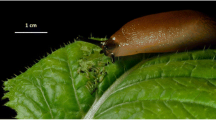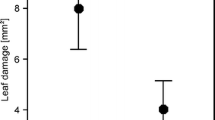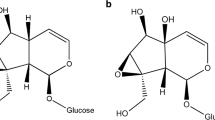Summary
To examine the effects of predators and plant genotype on the behavior, patterns of herbivory, growth and survivorship of caterpillars, we used an experimental garden in which we contrasted two hostplant genotypes of plantain (Plantago lanceolata), two kinds of herbivores (specialist Junonia coenia vs. generalist Pyrrharctia isabella) and two levels of caterpillar predation (with and without Podisus maculiventris stinkbugs). Each of the replicate plots per treatment contained two plants of the same genotype. The stinkbugs reduced the survivorship of the specialist caterpillars but not that of the generalists, which reflects the differences in predatoravoidance behaviors of these species. Nonetheless, the stinkbugs influenced the behavior of both caterpillar species. When stinkbugs were present, both specialist and generalist caterpillars were less likely to be found on the plant upon which they were initially placed (=“initial” plant), and they were more likely to be off both plants within the plot than larvae in the absence of predators. Consequently in the presence of the stinkbug predators, the proportion of the “initial” plants consumed was less than in the absence of the predators. Plant genotype influenced plant size and the proportion of individual plants eaten, but it did not affect larval location on the plots. Neither presence of predators nor plant genotype had an effect on relative growth rate of the caterpillars.
Similar content being viewed by others
References
Barbosa P (1988) Some thoughts on “The evolution of host range”. Ecology 69:912–915
Bernays E, Graham M (1988) On the evolution of host specificity in phytophagous arthropods. Ecology 69:886–892
Bobbitt JM, Segebarth KP (1969) Iridoid glycosides and similar substances. In: Taylor WI, Battersby AR (eds) Cyclopentanoid terpene derivatives. Dekker, New York, pp 1–145
Bowers MD (1984) Iridoid glycosides and hostplant specificity in larvae of the buckeye butterfly, Junonia coenia (Nymphalidae). J Chem Ecol 10:1567–1577
Bowers MD (1990) Recycling plant natural products for insect defense. In: Evans DL, Schmidt JO (eds) Insect defenses. State Univ New York Press, Albany, NY, pp 353–386
Bowers MD, Puttick GM (1986) The fate of ingested iridoid glycosides in lepidopteran herbivores. J Chem Ecol 12:169–178
Bowers MD, Stamp NE (1992) Chemical variation within and between individuals of Plantago lanceolata (Plantaginaceae). J Chem Ecol 18:985–995
Cates RG (1980) Feeding patterns of monophagous, oligophagous, and polyphagous insect herbivores: the effects of resource abundance and plant chemistry. Oecologia 46:22–31
Cavers PB, Bassett IJ, Crompton CW (1980) The biology of Canadian weeds. 47. Plantago lanceolata L. Can J Plant Sci 60:1269–1282
Cornell JC, Stamp NE, Bowers MD (1988) Variation and developmental change in activity of gregarious caterpillars, Hemileuca lucina (Saturniidae). Psyche 95:45–58
Dethier VG (1988) The feeding behavior of a polyphagous caterpillar (Diacrisia virginica) in its natural habitat. Can J Zool 66:1280–1288
Duff RB, Bacon JSD, Mundie CM, Famer VC, Russell JD, Forrester AR (1965) Catalpol and methyl catalpol: naturally occurring glycosides in Plantago and Buddleia species. Biochem J 96:1–5
El-Naggar LJ, Beal JL (1980) Iridoids: a review. J Nat Prod 43:649–707
Evans EW (1982) Influence of weather on predator/prey relations: stinkbugs and tent caterpillars. New York Entomol Soc 90:241–246
Gould WP, Jeanne RL (1984) Polistes wasps (Hymenoptera: Vespidae) as control agents for lepidopterous cabbage pests. Environ Entomol 13:150–156
Herrebout WM, Kuyten PJ, de Ruiter L (1963) Observations on colour patterns and behaviour of caterpillars feeding on Scots pine. Arch Neerl Zool 15:315–357
Ito Y, Miyashita K (1968) Biology of Hyphantria cunea Drury (Lepidoptera: Arctiidae) in Japan. V. Preliminary life tables and mortality data in urban areas. Res Popul Ecol 10:177–209
Iwao S, Wellington WG (1970) The influence of behavioral differences among tent caterpillar larvae on predation by a pentatomid bug. Can J Zool 48:896–898
Janzen DH (1988) On the broadening of insect-plant research. Ecology 69:905
Jensen SR, Nielsen BJ, Dahlgren R (1975) Iridoid compounds, their occurrence and systematic importance in the angiosperms. Bot Not 128:148–180
Lopez JD Jr, Ridgway RL, Pinnell RE (1976) Comparative efficacy of four insect predators of the bollworm and tobacco budworm. Environ Entomol 5:1160–1164
Mansour F, Rosen D, Shulov A (1981) Disturbing effect of a spider on larval aggregations of Spodoptera littoralis. Entomol Exp Appl 29:234–237
Mukerji MK, LeRoux EJ (1965) Laboratory rearing of a Quebec strain of the pentatomid predator, Podisus maculiventris (Say) (Hemiptera: Pentatomidae). Phytoprotection 46:40–60
Nakasuji F, Yamanaka H, Kiritani K (1973) Control of the tobacco cutworm Spodoptera litura F. with polyphagous predators and ultra low concentrations of chlorophenamidine. Jap J Appl Entomol Zool 17:171–180 (English summary)
National Climatic Data Center (1990) Climatological data New York 1990, vol. 102. Asheville, NC
Schmitt J, Niles J, Wulff RD (1992) Norms of reaction of seed traits to maternal environments in Plantago lanceolata. Am Nat (in press)
Schultz JC (1983) Habitat selection and foraging tactics of caterpillars in heterogeneous trees. In: Denno RF, McClure MS (eds) Variable plants and herbivores in natural and managed systems. Academic Press, New York, pp 61–90
Scott JA (1986) The butterflies of North America. Stanford Univ Press, Stanford, CA
Sokal RR, Rohlf FJ (1981) Biometry, 2nd ed. WH Freeman, New York
Stamp NE (1992) Relative susceptibility to predation of two species of caterpillar on plantain. Oecologia (in press)
Stamp NE, Bowers MD (1988) Direct and indirect effects of predatory wasps (Polistes sp.: Vespidae) on gregarious larvae of the buckmoth, Hemileuca lucina (Saturniidae). Oecologia 75:619–624
Stamp NE, Bowers MD (1991) Indirect effect on survivorship of caterpillars due to presence of invertebrate predators. Oecologia 88:325–330
Stamp NE, Bowers MD (1992) Behaviour of specialist and generalist caterpillars on plantain (Plantago lanceolata). Ecol Entomol 17 (in press)
Stamp NE, Wilkens RT (1992) On the cryptic side of life: being unapparent to enemies and the consequences for foraging and growth of caterpillars. In: Stamp NE, Casey TM (eds) Caterpillars: Ecological and evolutionary constraints on foraging. Chapman & Hall, New York (in press)
Thomas CD, Ng D, Singer MC, Mallet JLB, Parmesan C, Billington HL (1987) Incorporation of a European weed into the diet of a North American herbivore. Evolution 41:892–901
Tietz HM (1972) An index to the described life histories, early stages and hosts of the Macrolepidoptera of the continental United States and Canada, Vol. II. Allyn Museum, Sarasota, FL
Tostowaryk W (1971) Life history and behavior of Podisus modestus (Hemiptera: Pentatomidae) in boreal forest in Quebec. Can Entomol 103:662–673
Werner EE, Gilliam JF (1984) The ontogenetic niche and species interactions in size-structured populations. Annu Rev Ecol Syst 15:393–425
Wu L, Antonovics J (1975) Experimental ecological genetics of Plantago. I. Induction of roots and shoots on leaves for large scale vegetative propagation and metal tolerance testing in P. lanceolata. New Phytol 75:277–282
Yamanaka K, Nakasuji F, Kiritani K (1972) Life tables of the tobacco cutworm Spodoptera litura (Lepidoptera: Noctuidae) and the evaluation of effectiveness of natural enemies. Jap J Appl Entomol Zool 16:205–214 (English summary)
Zar JH (1984) Biostatistical analysis, 2nd ed. Prentice-Hall, Englewood Cliffs, NJ
Author information
Authors and Affiliations
Rights and permissions
About this article
Cite this article
Stamp, N.E., Bowers, M.D. Foraging behavior of specialist and generalist caterpillars on plantain (Plantago lanceolata) altered by predatory stinkbugs. Oecologia 92, 596–602 (1992). https://doi.org/10.1007/BF00317854
Received:
Accepted:
Issue Date:
DOI: https://doi.org/10.1007/BF00317854




